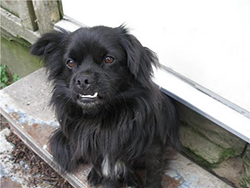 Lenny was saved from the “kill list” by a flight coordinated on the Pilots N Paws message board.
Lenny was saved from the “kill list” by a flight coordinated on the Pilots N Paws message board.
Lenny—a small, black Pekingese mix dog—arrived at Murray County Shelter in Chatsworth, Ga., with matted fur and signs of neglect. He had fleas, ticks, and heartworms, and after a few days at the shelter, he was slated to be on the “kill list.” But Lenny was saved from the list when a pilot brought him to a rescue group that nursed him back to health and found him a home in Hamburg, N.Y.
“He is just perfect for our family, and is so sweet and loving,” said Sherry Phillips, who adopted Lenny after a flight coordinated on the Pilots N Paws Web site gave him a second chance.
Animal shelters in “high kill” areas such as Lenny’s home state of Georgia and other parts of the South deal with too many stray animals to house or find homes for them all and euthanize many unclaimed or abandoned pets. Pilots N Paws connects animal shelters and pet rescue groups with volunteer pilots who take animals to facilities in areas where their chances of adoption are high. This September, the site has set a goal of saving 5,000 animals in a week using general aviation.
Pilots N Paws 5000 will take place Sept. 12 through 20 and is designed to raise awareness of the need to transport animals to areas with homes available—and the vital role of GA in accomplishing that goal.
Co-founders Debi Boies and Jon Wehrenberg created Pilots N Paws 18 months ago after Wehrenberg flew a rescued Doberman from Florida to South Carolina so that Boies could adopt it. Boies, who is not a pilot, explained the long and arduous journey of ground transportation, and Wehrenberg asked if there was a need for pilots to take animals to different parts of the country. Now, more than 600 pilots have helped rescue animals with flights coordinated on the Pilots N Paws message board.
 Peanut was taken to a shelter to be put down after he broke his leg in a fall from a second-story window. He was rescued and transported in a Pilots N Paws flight.
Peanut was taken to a shelter to be put down after he broke his leg in a fall from a second-story window. He was rescued and transported in a Pilots N Paws flight.
“They go above and beyond whatever’s called for—it’s not just flying,” Boies said. She said some pilots have even temporarily fostered dogs or driven the animals when the flight had to be delayed or canceled because of bad weather. “It touches me every time I think about it.”
Boies said areas with ineffective spay and neuter programs and pet ownership responsibility laws have animal overpopulation problems, but other areas have shelters with adoption waiting lists. General aviation can transport pets to areas with adoptive families more quickly than ground transportation, and without exposing the animals to as many strangers. Onerous security requirements and crippling fees threaten this successful way to transport animals, the Pilots N Paws Web site states.
“Let’s face it—if you’re not a pilot and don’t know someone who is, you don’t know what general aviation does for this country,” Boies said.
She said shelters and pet rescue groups have already posted requests for the Pilots N Paws 5000 event, many of which are still looking for pilots to connect the sending and receiving facilities. Journeys of 300 miles or less can usually be done in one flight, while longer distances can be covered in two legs, with pilots coordinating their flights to cover the whole distance. While most of the animals transported are dogs or cats, other passengers have included bunnies, a boa constrictor, and even a potbelly pig.
Pilots can find out more about volunteering for Pilots N Paws and about flights needed in their area on the Pilots N Paws Web site.
